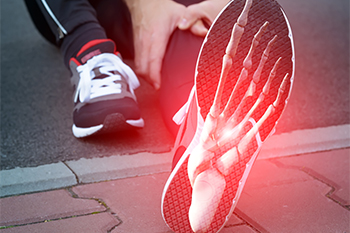Items filtered by date: March 2024
Accelerating Recovery From a Broken Ankle

Recovering from a broken ankle can be a challenging journey, but there are steps individuals can take to expedite the healing process and regain mobility sooner. This can begin by following the guidance of a podiatrist and adhering to the prescribed treatment plan, which may include immobilization through a cast or brace. Elevating the injured ankle above heart level can help reduce swelling and alleviate discomfort. Engaging in gentle range-of-motion exercises can prevent stiffness and promote flexibility in the ankle joint. Adequate nutrition, including foods rich in calcium and vitamin D, supports bone health and aids in the healing process. Finally, maintaining a positive mindset and practicing patience are essential aspects of recovery, as healing from a broken ankle takes time and diligence. If you have broken your ankle, it is suggested that you are under the care of a podiatrist who can provide you with additional recovery tips.
Broken ankles need immediate treatment. If you are seeking treatment, contact Jordan Baker, DPM from Best Foot Forward Surgical Podiatry. Our doctor can provide the care you need to keep you pain-free and on your feet.
Broken Ankles
A broken ankle is experienced when a person fractures their tibia or fibula in the lower leg and ankle area. Both of these bones are attached at the bottom of the leg and combine to form what we know to be our ankle.
When a physician is referring to a break of the ankle, he or she is usually referring to a break in the area where the tibia and fibula are joined to create our ankle joint. Ankles are more prone to fractures because the ankle is an area that suffers a lot of pressure and stress. There are some obvious signs when a person experiences a fractured ankle, and the following symptoms may be present.
Symptoms of a Fractured Ankle
- Excessive pain when the area is touched or when any pressure is placed on the ankle
- Swelling around the area
- Bruising of the area
- Area appears to be deformed
If you suspect an ankle fracture, it is recommended to seek treatment as soon as possible. The sooner you have your podiatrist diagnose the fracture, the quicker you’ll be on the way towards recovery.
If you have any questions, please feel free to contact our office located in Florence, SC . We offer the newest diagnostic and treatment technologies for all your foot care needs.
Foot and Ankle Injuries in Football

In the high-stakes arena of football, players frequently contend with a spectrum of foot and ankle injuries that can sideline them from the game. Among the most prevalent injuries are ankle sprains, often caused by sudden changes in direction or awkward landings. Achilles tendon ruptures, while less common, can require extensive rehabilitation. Metatarsal fractures, particularly in the fifth metatarsal, are also frequent, often resulting from direct trauma or overuse. Additionally, plantar fasciitis, a painful condition affecting the tissue connecting the heel to the toes, can impair mobility and cause persistent discomfort. Turf toe, though seemingly minor, can hinder performance and require careful management. Lisfranc injuries, affecting the midfoot, demand prompt attention to prevent long-term complications. If you have endured a foot or ankle injury while playing football, it is suggested that you consult a podiatrist as quickly as possible.
Sports related foot and ankle injuries require proper treatment before players can go back to their regular routines. For more information, contact Jordan Baker, DPM of Best Foot Forward Surgical Podiatry. Our doctor can provide the care you need to keep you pain-free and on your feet.
Sports Related Foot and Ankle Injuries
Foot and ankle injuries are a common occurrence when it comes to athletes of any sport. While many athletes dismiss the initial aches and pains, the truth is that ignoring potential foot and ankle injuries can lead to serious problems. As athletes continue to place pressure and strain the area further, a mild injury can turn into something as serious as a rupture and may lead to a permanent disability. There are many factors that contribute to sports related foot and ankle injuries, which include failure to warm up properly, not providing support or wearing bad footwear. Common injuries and conditions athletes face, including:
- Plantar Fasciitis
- Plantar Fasciosis
- Achilles Tendinitis
- Achilles Tendon Rupture
- Ankle Sprains
Sports related injuries are commonly treated using the RICE method. This includes rest, applying ice to the injured area, compression and elevating the ankle. More serious sprains and injuries may require surgery, which could include arthroscopic and reconstructive surgery. Rehabilitation and therapy may also be required in order to get any recovering athlete to become fully functional again. Any unusual aches and pains an athlete sustains must be evaluated by a licensed, reputable medical professional.
If you have any questions please feel free to contact our office located in Florence, SC . We offer the newest diagnostic and treatment technologies for all your foot and ankle needs.
Let the Expert Treat Your Ingrown Toenails
Foot Problems in Runners

As any seasoned runner knows, the journey on the road, track, or trail often comes with its fair share of foot problems. From painful blisters caused by excessive friction to toenail damage due to ill-fitting shoes or forward foot sliding, runners face a myriad of challenges. One of those is stiffness and discomfort in the big toe, termed hallux rigidus, which can make each step agony. Plantar fasciitis is often felt most strongly in the heel. This condition is caused by inflammation in the tissue that runs along the foot's bottom and is particularly common in flat-footed or high-arched runners. Stress fractures, metatarsalgia, and Morton's neuroma are additional ailments that runners may encounter, stemming from overuse, improper footwear, or biomechanical issues. Seeking help from a podiatrist is suggested for proper diagnosis and treatment of these conditions. This foot doctor can provide tailored advice on footwear, running technique adjustments, and offer treatment options to alleviate foot pain and prevent future injury.
Exercising your feet regularly with the proper foot wear is a great way to prevent injuries. If you have any concerns about your feet, contact Jordan Baker, DPM of Best Foot Forward Surgical Podiatry. Our doctor will treat your foot and ankle needs.
How to Prevent Running Injuries
Many common running injuries are caused by overuse and overtraining. When the back of the kneecap starts wearing out and starts causing pain in your knee, this is commonly referred to as runner’s knee. Runner’s knee is a decrease in strength in your quadriceps and can occur if you’re not wearing properly fitted or supporting shoes. To prevent runner’s knee, focusing on hip strengthening is a good idea, as well as strengthening your quads to keep the kneecaps aligned.
What Are Some Causes of Running Injuries?
- One cause of a common running injury is called iliotibial band syndrome.
- Plantar fasciitis is also another common injury.
- Stress fractures can occur from overtraining, lack of calcium, or even your running style.
Best Ways to Prevent Running Injuries
- Wear footwear that fits properly and suits your running needs.
- Running shoes are the only protective gear that runners have to safeguard them from injury.
- Make a training schedule. Adding strengthening exercises as well as regular stretching can help keep you strong and limber and can lessen the possibility of injuries.
- Stretching keeps muscles limber; this will help you gain better flexibility.
If you have any questions please feel free to contact our office located in Florence, SC . We offer the newest diagnostic and treatment technologies for all your foot and ankle needs.
Selecting the Perfect Running Shoes for Various Terrains

Choosing the right running shoes tailored to different terrains is vital for optimal performance and injury prevention. For road running, prioritize lightweight shoes with ample cushioning to absorb impact on hard surfaces. Look for durable outsoles with good traction for stability and grip on pavement. Trail running demands shoes with rugged outsoles and aggressive tread patterns to navigate uneven terrain and provide traction on dirt, mud, and rocks. Opt for shoes with protective features, such as rock plates or toe guards to shield your feet from sharp objects. In wet or slippery conditions, consider waterproof or water-resistant shoes with quick-drying materials to keep your feet dry and comfortable. When running on tracks, lightweight and responsive shoes with minimal cushioning are ideal for speed and agility. Finally, for cross-country running, choose versatile shoes that offer a balance of cushioning, support, and traction to handle various surfaces. By selecting the appropriate footwear for each terrain, you can enhance your running experience and minimize the risk of injuries. If you are seeking additional information about what type of shoes to choose for your preferred running style, it is suggested that you consult a podiatrist.
If you are a runner, wearing the right running shoe is essential. For more information, contact Jordan Baker, DPM from Best Foot Forward Surgical Podiatry. Our doctor can provide the care you need to keep you pain-free and on your feet.
Choosing the Right Running Shoe for Your Foot Type
To increase performance and avoid the risk of injury, it is important to choose the right running shoe based on your foot type. The general design of running shoes revolves around pronation, which is how the ankle rolls from outside to inside when the foot strikes the ground.
- Neutral runners are able to choose from a wide variety of shoes, including minimalist shoes or even going barefoot.
- Runners who overpronate, or experience an over-abundance of ankle rolling, should choose shoes that provide extra motion control and stability.
- Runners who underpronate, or supinate, have feet that have high arches and lack flexibility, preventing shock absorption. They require shoes with more flexibility and cushion.
If you have any questions please feel free to contact our office located in Florence, SC . We offer the newest diagnostic and treatment technologies for all your foot and ankle needs.

